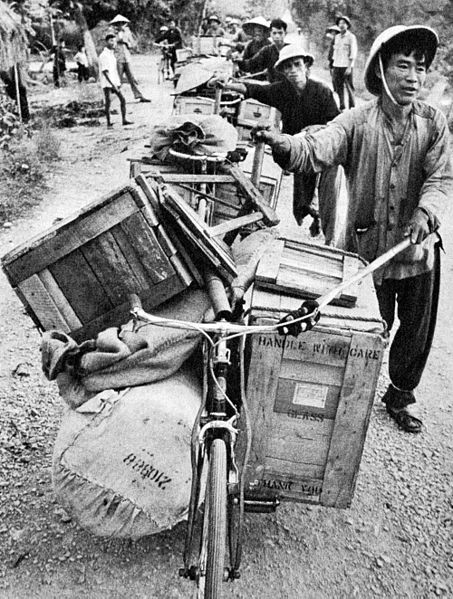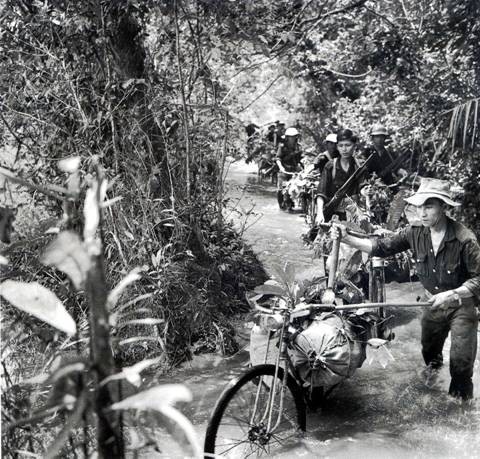(VOVworld)- The Ho Chi Minh trail, also called the Truong Son trail, was constructed in 1959 to carry supplies to the southern battlefield during the war. For 16 years, the Ho Chi Minh trail played a key role in the liberation of southern Vietnam and national reunification. The trail has become a legend and a symbol of the Vietnamese people’s staunch spirit and the solidarity between Vietnam, Laos and Cambodia. To mark the trail’s 55th anniversary, VOV brings you an article titled “Ho Chi Minh Trail - the supply line to the battlefield”.
The Ho Chi Minh trail was part of the strategic military transport network that went through central Vietnam, Laos and Cambodia. The trail was built to bring troops, food, and ammunition to the southern liberation forces and Vietnam People’s Army during Vietnam’s anti-US war from 1959 to 1975. The trail system was named after the Truong Son range which stretches through central Vietnam. The trail was later called the Ho Chi Minh trail and ran through many provinces in Vietnam.
Hardships and difficulties in building the legendary trail
On May 19, 1959, the Central Military Party Committee set up Army Corps 559, now called Army Corps 12, of Truong Son soldiers and ordered it to find a way to supply the southern battlefield. The corps dug and levelled about 29 million cubic meters of soil and rocks and built a road system of 5 vertical axes and 21 horizontal axes in the east and west of Truong Son range with a total length of nearly 20,000 km. On these roads, Truong Son soldiers and other troops shot down and damaged more than 2,400 American planes. Colonel Le Kim Tho is a former officer of the Command of Army Corps 559 said:“There were always enemy bombs and warplanes. Several soldiers died. Despite bombs and warplanes, our soldiers managed to build the road to supply the southern battlefield”.

Bike on Ho Chi Minh Trail during the anti-US war. Photo: internet
|
During 16 years of fierce fighting, Truong Son soldiers and officers of engineer, transport, artillery, infantry, communications, and militia units, and many civilians suffered hardships and even sacrificed their lives to build these roads.
Ho Chi Minh trail contributes to the historic victory
The Truong Son- Ho Chi Minh trail served battlefields in Vietnam, Laos, and Cambodia. Major general Do Giang Nam, the current Commander of Army Corps 12 and General Director of the Truong Son Construction Corporation, said: “Thanks to the Truong Son supply pipe, we transported more than 2 million tons of ammunition and more than 2 million people to the battlefields. Thanks to this trail, the Vietnamese army conducted several major marches accompanied by tanks and heavy artillery to the southern battlefield. This changed the balance of power and enabled us to win major victories with the climaxes being general uprisings in 1968 and 1975”.
Trail contributes to national development
The Ho Chi Minh trail has changed a lot since the war ended. 55 years ago, it was the supply pipe to the southern battlefield and now it has become an important transport route contributing to the economic development of cities and provinces along the route. Major general Giang Nam told VOV: “The Vietnamese Party and State have invested a great deal in upgrading the trail, considering it a route of industrialization and modernization. Wherever the road system goes, it increases local socio-economic potential and provides a paved alternative National Highway 1. The development of the road system along the Ho Chi Minh trail has boosted social security in remote areas and national defense”.
 |
Minister of Defense General Phung Quang Thanh said the Party and State have paid special attention to tapping the potential of these transport routes: “We need to uphold the spirit of independence and democracy and promote national strength. We will develop the Truong Son trail into a complete transportation network to promote socio-economic development in western Vietnam thus reducing poverty, developing a commodity economy, defending national security and the western border, as well as contributing to national economic development”.
The trail, which ran through mountains and forests to transport supplies from the north to the south, now has become the main transport route running in parallel with National Highway 1. The road has become a national historical relic of the glorious struggle for national liberation.